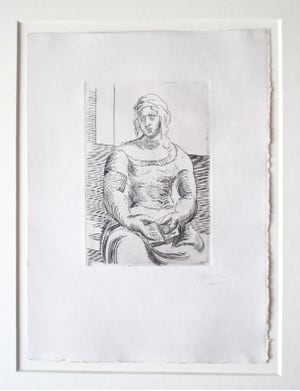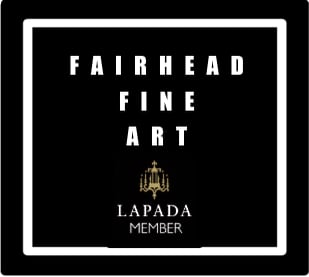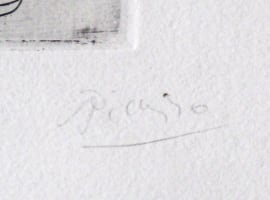
Le Italienne avec un livre
Medium: Original Etching in black & white, 1918/ 1919 , on Arches paper, signed by the artist in pencil
Edition: 50.
Size: 149 x 100 mms (Image size)
References:
Bloch, Georges. Pablo Picasso, catalogue de l'oeuvre gravé et lithographié, 4 vol. Berne: Kornfeld and Klipstein. 1968-1979. (I:34)
Geiser, Bernhard and Brigitte Baer. [GB.96] (Ba) Picasso: Peintre-Graveur, Catalogue raisonné de
l'oeuvre gravé et des monotypes, 7 vols. Berne: Kornfeld. 1986-1996.Baer 96.B.a
Goeppert, Sebastian, Herma Goeppert-Frank & Patrick Cramer. Pablo Picasso: Catalogue
Raisonné des livre Illustres. Geneva: Patrick Cramer. 1983. (Cramer 8)
Goeppert, Sebastian, Herma Goeppert-Frank & Patrick Cramer. Pablo Picasso: The Illustrated
Books. Geneva: Patrick Cramer. 1983. (Cramer 8)
Mallen, Enrique, ed. Online Picasso Project. Sam Houston State University. 1997-2016. (18:163)
Mössinger, Ingrid, Beate Ritter, Kerstin Drechsel & Pierre Daix. Picasso et les femmes / Picasso
und die Frauen (Kunstsammlung Chemnitz, 20/22 Oktober, 2002 - 19 Januar, 2003). Koln: DuMont.
2002. (140p)
Palau i Fabre, Josep. Picasso. From the Ballets to the Drama (1917-1926). Köln: Könemann. 1999.
(III:551)
Palau i Fabre, Josep. Picasso: Dels ballets al drama (1917-1926). Barcelona: Ediciones Polígrafa.
1999. (III:551)
Note: This was issued in the book “Le Tricorne” . The etching was supplied loose in a japan folder with title on the front cover and printers address on the back, colophon and grey number on the inside flap.
This etching was the result of a co-operation with the Russian Ballet Master : Serge Diagalev who had been thinking of creating a Spanish ballet since 1916. Through his friend Igor Stravinsky he met the young Spanish Composer, Manuel de Falla and requested him to make the score for his new ballet. Diagalev went on to commission Picasso to design the sets and costumes for the ballet which was called “Le Tricorne” after the three cornered hat worn by the hero in the plot. Picasso and his wife Olga travelled to London and were in England for three months working on the project. Picasso created twenty different studies for the stage sets and the designs finally chosen were illustrated in the album containing our etching. The ballet was performed for the first time in London in 1919 and the following year it had it’s premier in Paris. The album was in fact published by Paul Rosenburg who by this time had become Picasso’s official dealer (Kahnweiller had lost his money by the French government requisitioning his business in the aftermath of the first World War. Faced with this tragedy the young art dealer was unable to pay Picasso moneys owed to him. The unforgiving artist, at this point, deserted his former patron, protector and friend). It happens that some of the documentation surrounding this etching is still to be found in the archives - but is in no way complete. There is a letter from Paul Rosenburg to Picasso dated 21/9/1919 suggesting an edition of 15 examples to be sold at 75 Francs per work. In the event this project was not fulfilled and the etching was created to accompany the album described above.
The Italian of the etching represents a character in the ballet and also a superb portrait of a similar theme was made in 1919 (see Zervos. III.363)
Published by: Gallerie Paul Rosenberg, Paris
Printed by : Ateliers Andre Marty; Daniel Jacomet et Cie, Paris
Public Collections: New York University - Gift of Edward Albeee, 1968
Condition: In good condition.

